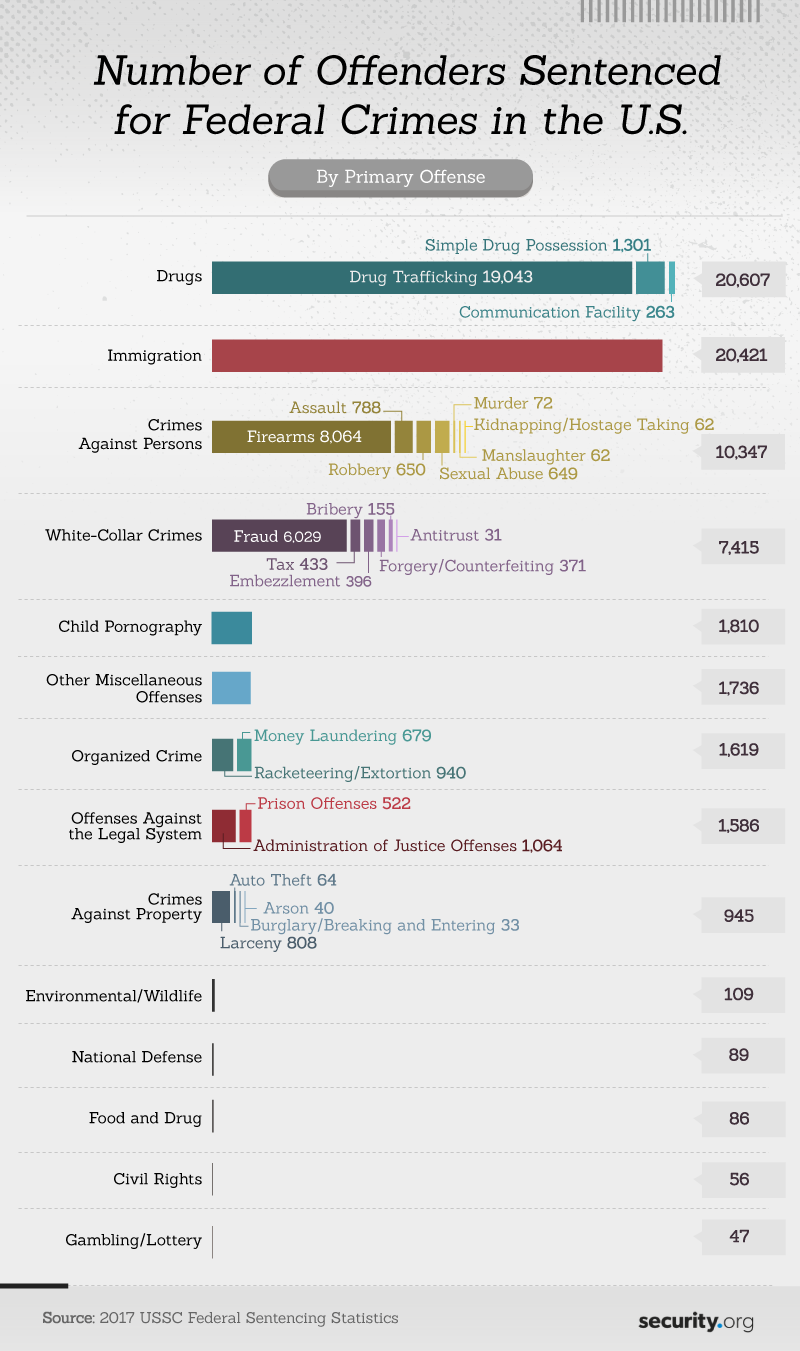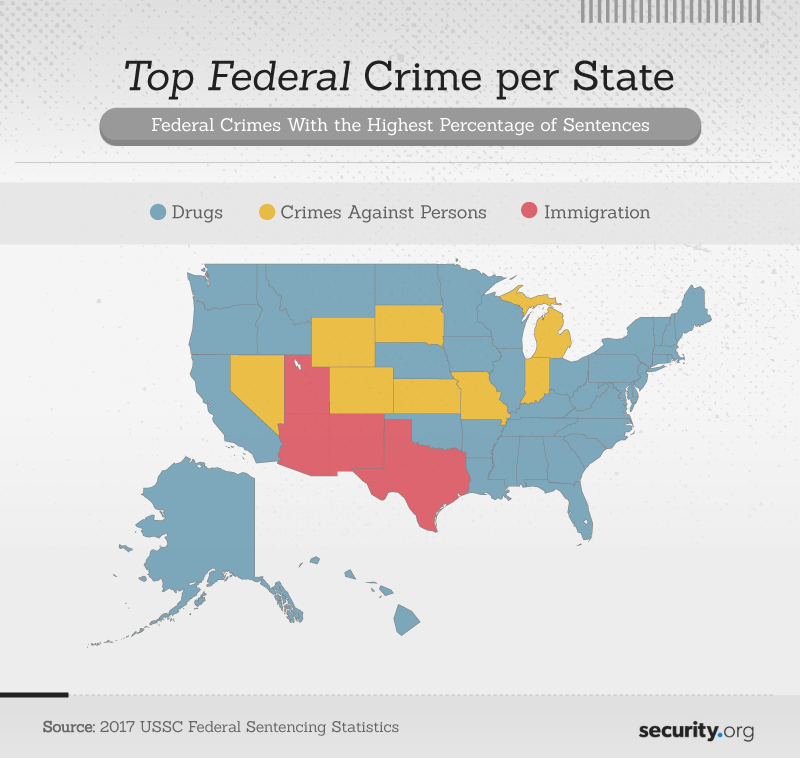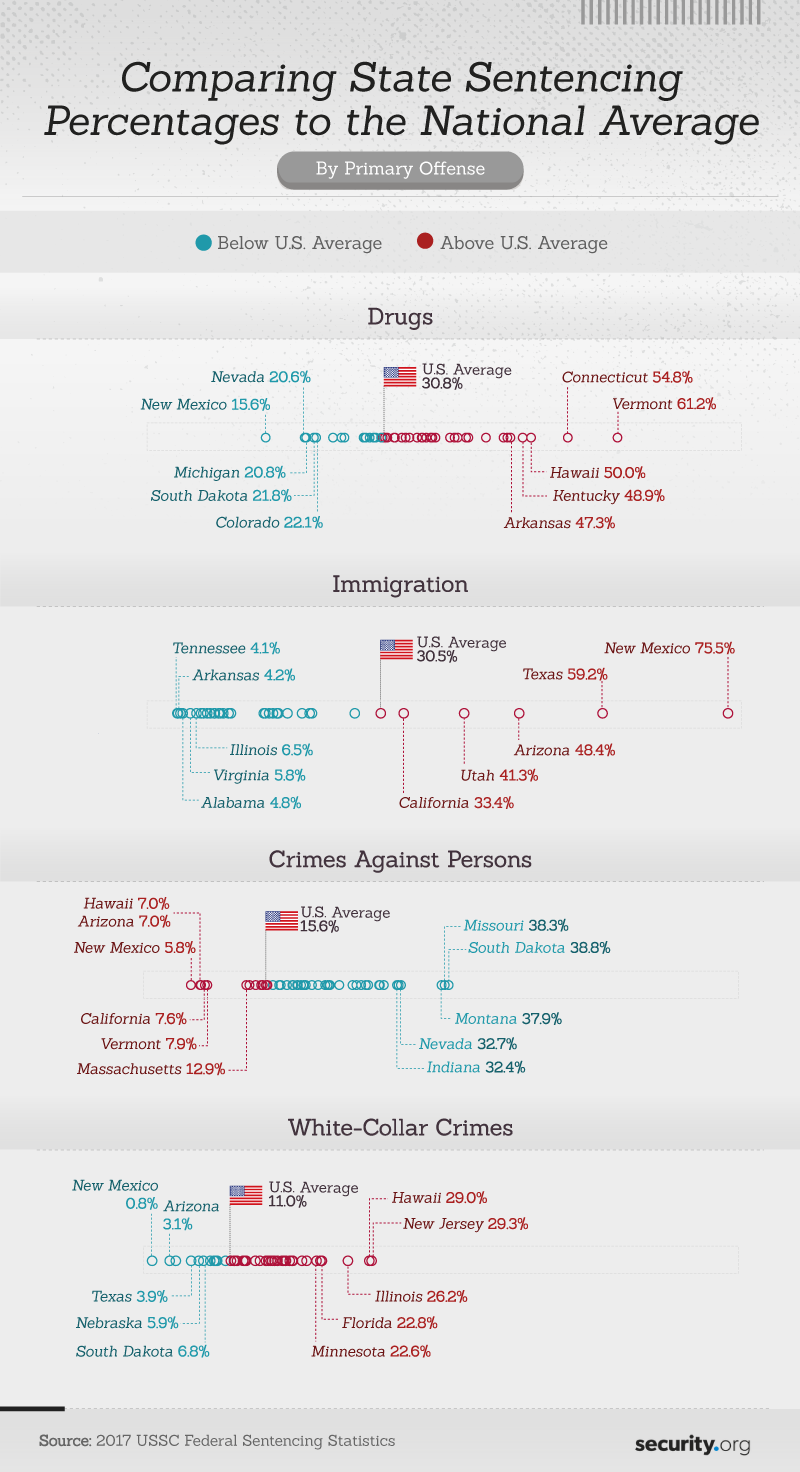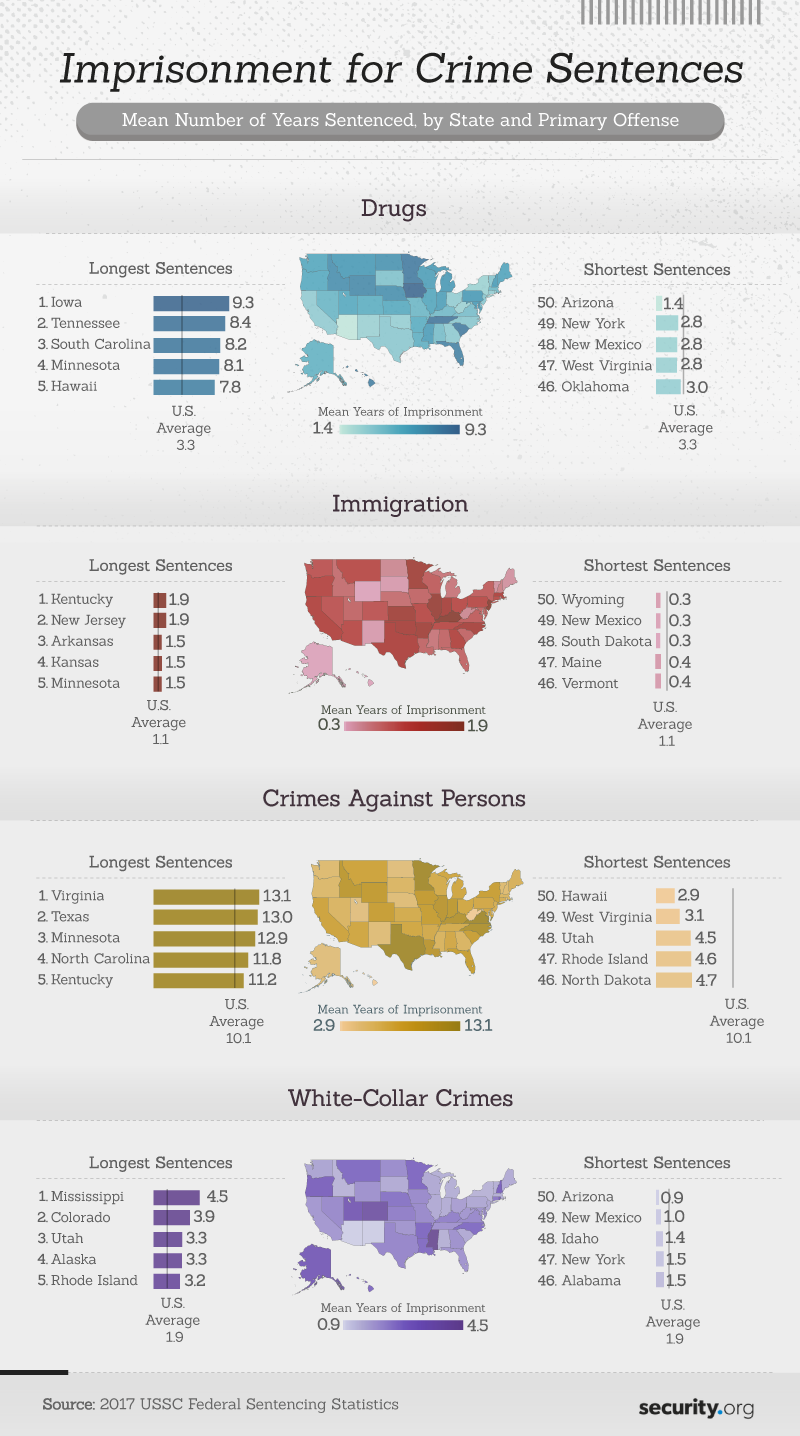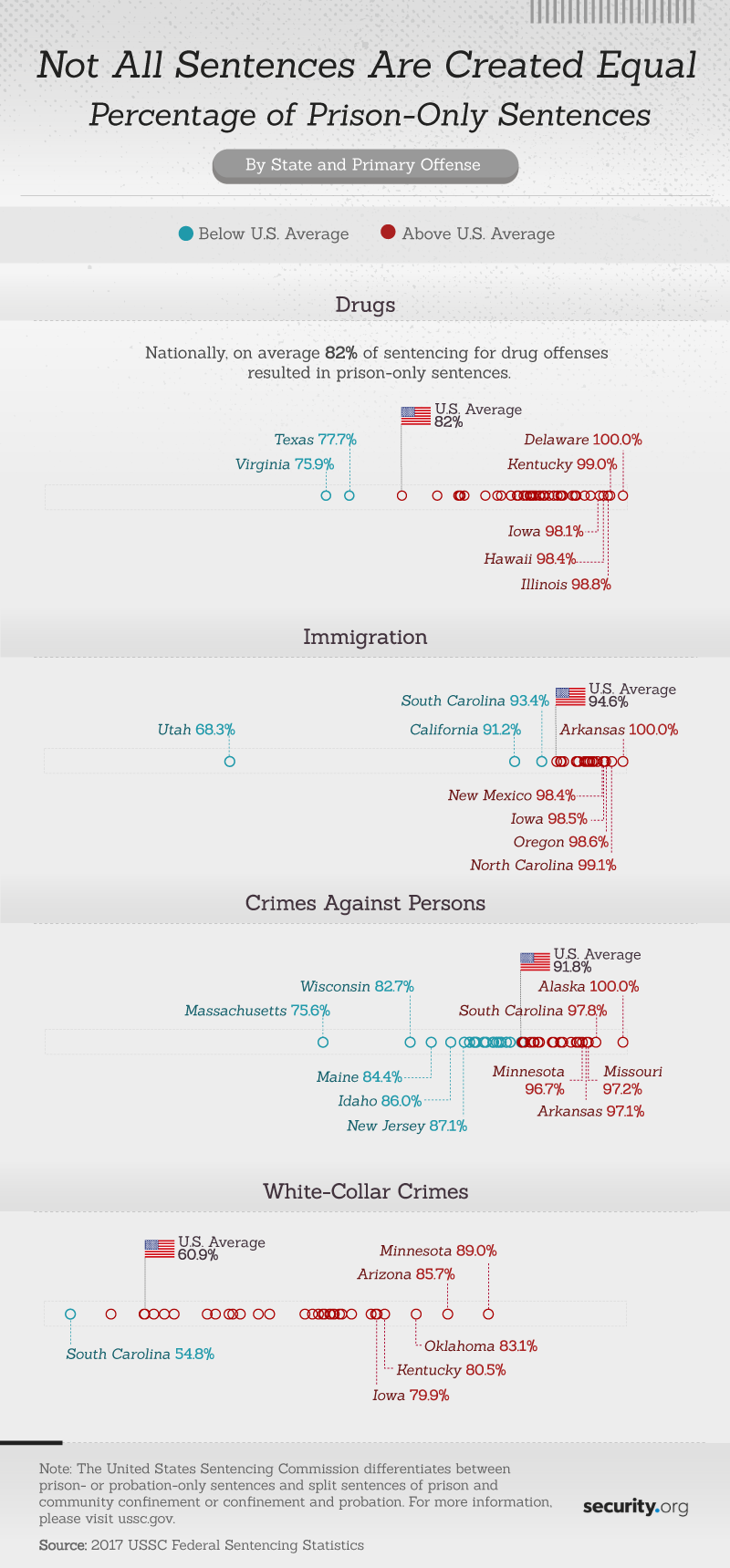Crimes and Convictions
Examining United States Sentencing Commission Federal Sentencing Statistics
In almost every nation in the world, governments rule the land with some form of prison or punishment. But in the United States, prisons are a particularly massive institution. More than 2.2 million people are incarcerated in the U.S., according to numbers from the U.S. Bureau of Justice Statistics (BJS), and that includes about 1 percent of the entire country’s adult males. In fact, the U.S. has one of the highest incarceration rates in the world – an estimated 450 people are in prison per 100,000 residents.
But what crimes are these individuals committing – and what states sentence the most offenders? We evaluated data from the United States Sentencing Commission’s Federal Sentencing Statistics to find the most common federal crime in each state, the typical legal repercussions, and what this could mean for potential residents who are trying to lead safe lives. Read on to find out what’s going on in your area and, more importantly, what the courts are doing about it.
Common Sentences Nationwide
There are an estimated 701,000 full-time police officers in the United States, according to the BJS’s most recent numbers. But what crimes take up most of law enforcement’s attention?
Our analysis suggests that the most common federal crime individuals were convicted of and sentenced for involved drugs, followed by immigration-related crimes. Of the roughly 20,600 drug offenses recorded, most – 19,043 – involved drug trafficking (about 1,300 sentences were related to simple drug possession). Meanwhile, the third most common offense individuals were sentenced for involved “crimes against persons,” such as sexual abuse, assault, murder, kidnapping, robbery, and firearms-related charges.
Sentencing Over Time
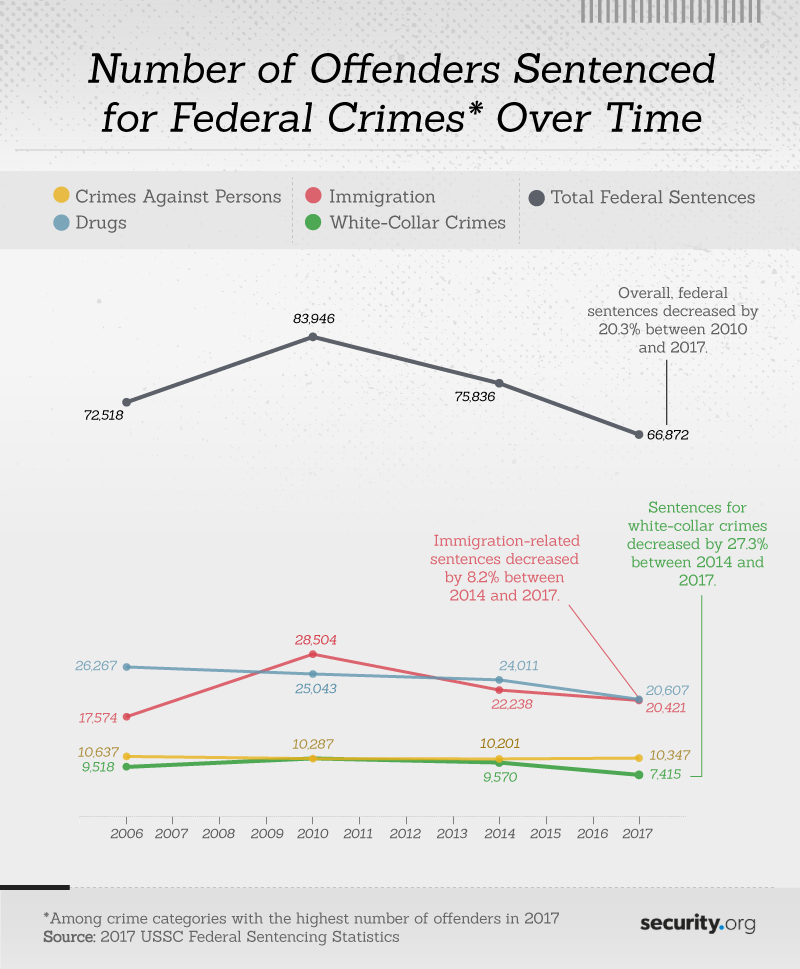
The data suggest that federal crime sentencing has decreased between 2006 and 2017. Between 2010 and 2017, the total number of sentences decreased by 20.3% . Immigration-related sentences decreased by 8.2% from 2014 to 2017, sentences for white-collar crimes decreased by 27.3% in that same period of time.
Most Sentenced Federal Crimes
Crime occurs all across the U.S., but certain states are known to crack down on specific offenses in particular. We examined government data to see which federal crimes had the highest percentage of sentences in each state. Interestingly, Southern conservative states such as Texas, New Mexico, Arizona, and Utah sentenced individuals for immigration-related crimes the most. Drug charges made up the highest percentage of sentences on the East and West Coasts, and some states in the Midwestern and Pacific regions (for example, Colorado, Kansas, Missouri, and Nevada) tended to sentence individuals most for crimes against persons.
Sentencing Across the Country
This may alarm you, but the FBI estimates that one murder happens every 30.5 minutes in the United States, while a burglary occurs every 22.6 seconds. While these crimes are, no doubt, widespread, some parts of the nation are known to be hotbeds for various offenses.
We compared state sentencing percentages to the national average to see which regions stood out. Perhaps surprisingly, Vermont stood out for having the highest sentencing rate for drugs. At the same time, New Mexico topped the charts for sentences related to immigration, and New Jersey had the highest sentencing rate for white-collar crimes. However, this doesn’t necessarily mean these states have the highest crime rates for each of these categories – rather, these states might simply be the most proactive about charging and sentencing individuals.
Jail Times, by State
When it comes to jail time, it’s not just a matter of what criminals do – it’s also where they do it. So which states hand out the harshest prison sentences for various crimes?
For drug-related offenses, Iowa ranked the highest with a mean of 9.3 years of jail time. Tennessee, South Carolina, Minnesota, and Hawaii rounded out the top five. Arizona seemed to be the most lenient for such crimes with an average sentence of 1.4 years.
For immigration-related crimes, states were fairly similar overall. Nevertheless, Kentucky and New Jersey tied for the longest average sentence at 1.9 years, while South Dakota, New Mexico, and Wyoming were the most lenient, with an average of 0.3 years.
For crimes against persons, states were generally much harsher in sentencing. Virginia ranked up top with 13.1 years of jail time on average, followed closely by Texas, Minnesota, North Carolina, and Kentucky. All these states dish out more than 10 years of prison time on average for crimes against persons. Conversely, Hawaii was the most lenient at 2.9 years.
White-collar crimes received the longest sentences in Mississippi – an average of 4.5 years. In Arizona, however, white-collar crimes only average 0.9 years of jail time.
Prosecution Prevalence
Prison isn’t the only way to punish a crime, but it’s often considered the most severe way. We examined how states deal with specific offenses, particularly whether or not those convicted exclusively received jail time. Certainly, there were some noticeable outliers.
For drug-related offenses, about 76 percent to 77 percent of individuals convicted got jail time in Texas and Virginia, whereas many states dished out jail sentences 91 percent or more of the time. White-collar crimes showed significant variation, as did crimes against persons. Utah stood out as giving jail time only 68 percent of the time for immigration-related crimes – a large outlier from the rest of the group, which tended to dole out prison sentences in 90 percent or more of their cases.
On the Lookout
Although crime is on a general decline in the U.S. compared to decades before, it’s no secret that thousands of families are impacted each year by lawbreaking and incarceration alike. For that reason, we analyzed government data from the United States Sentencing Commission’s Federal Sentencing Statistics to understand the fickle dynamics of crime sentencing around the country. In the process, we uncovered key insights that could change how both law enforcement and residents understand their own backyards.
On a societal level, these data could potentially point out regions proactive in prosecuting certain crimes as well as states that are over-prosecuting them. By that same logic, this intel could shine a light on the leniency or harshness of various states for heinous or minor offenses.
Methodology
For this project, we evaluated data from the United States Sentencing Commission’s (USSC) 2017 Federal Sentencing Statistics. It presents crime sentencing statistics for different types of crime for all U.S. states and outlying areas. We decided to only focus on the 50 U.S. states. The national overviews and averages in this project are derived from the national tables provided by the USSC. To show the length of imprisonment, we calculated the mean years of imprisonment using the mean months reported for each state by the USSC. Sentencing rates and percentages of different sentences were provided in the Federal Sentencing Statistics. To exclude outliers when comparing state sentencing percentages and percentages of prison sentences, we only included states that sentenced at least a total of 26 offenders for the crimes represented.
We did include all states in the asset showing the average length of imprisonment by state. The following states sentenced less than 26 offenders to prison:
Drugs: Rhode Island
Immigration: Indiana, Kentucky, New Jersey, Minnesota, Vermont, Missouri, Rhode Island, Wisconsin, West Virginia, Delaware, Maine, Connecticut, Montana, Hawaii, Alaska
Crimes against persons: Delaware, Rhode Island, Vermont, Hawaii
White-collar crimes: New Mexico, New Hampshire, South Dakota, Alaska, Rhode Island, Vermont, Wyoming, North Dakota, Delaware
Fair Use Statement
Do you want to share these findings on federal crime sentencing with others? The graphics and information found on this website are available for noncommercial reuse. Feel free to share them as much as you’d like across the web and on social media, but please make sure to link back to this page. Thank you!


